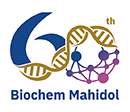“Evolution of DNA Sequencing” by Dr. Duangjai Khattiyos Coordinating director, U2Bio
Author: Webmaster
BC Faculty Seminar: July 2, 2025
“ATMP Research and Innovation at Faculty of Science Mahidol University and our industrial connections” by Assoc. Prof. Patompon Wongtrakoongate Department of Biochemistry, Faculty of Science
Cannabinoid Receptor Type 2 Agonist, GW405833, Reduced the Impacts of MDA-MB- 231 Breast Cancer Cells on Bone Cells
Breast cancer frequently metastasizes to bones, leading to debilitating osteolytic lesions. This occurs due to a disruption in the delicate equilibrium between bone formation by
Nanoencapsulation of vitamin B2 using chitosan-modified PLGA nanoparticles: synthesis, characterization, and in vitro studies on simulated gastrointestinal stability and delivery
Vitamin B2 (riboflavin) is important for keeping our cells healthy, but it breaks down easily in light, does not dissolve well in water, and is
Determination of 3-hydroxyanthranilic acid in the sweat of healthy older adults.
3-Hydroxyanthranillic acid (3HAA) is a substance made during tryptophan metabolism and is linked to aging and age-related diseases. This study developed a simple and fast
Development and in vitro evaluation of ursolic acid-loaded poly(lactic-co-glycolic acid) nanoparticles in cholangiocarcinoma
Cholangiocarcinoma (CCA) is a type of cancer that affects the bile ducts and is a major health issue in northeastern Thailand and nearby areas. It
Mechanisms and applications of bacterial luciferase and its auxiliary enzymes
Bacterial luciferase (LuxAB) catalyzes the conversion of reduced flavin mononucleotide (FMNH2), oxygen, and a long-chain aldehyde to oxidized FMN, the corresponding
BC Faculty Seminar: March 5, 2025
“The C2B domain orchestrates calcium/phospholipid binding and oligomerization in neuronal copine” by Mikhail Khvochtchev, Ph.D. Department of Biochemistry, Faculty of Science Mahidol University Date: March
KHDRBS3 facilitates self-renewal and temozolomide resistance of glioblastoma cell lines
Glioblastoma is a highly aggressive and fatal tumor characterized by the presence of glioblastoma stem cells (GSCs), which contribute significantly to tumor recurrence and resistance







